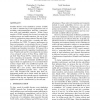11112 search results - page 41 / 2223 » Computing Stuttering Simulations |
CMOT
2002
13 years 8 months ago
2002
We introduce a diffusion of innovation model based on a network threshold approach. Realistic network and threshold data were gathered regarding the diffusion of new software tool...
WSC
1997
13 years 10 months ago
1997
Parallel discrete event simulation systems (PDES) are used to simulate large-scale applications such as modeling telecommunication networks, transportation grids, and battlefield...
HICSS
2003
IEEE
14 years 2 months ago
2003
IEEE
1 In the complexity and simulation communities there is growing support for the use of bottom-up computer-based simulation in the analysis of complex systems. The presumption is th...
ISQED
2006
IEEE
14 years 3 months ago
2006
IEEE
This paper proposes a simulation-based soft error estimation methodology for computer systems. Accumulating soft error rates (SERs) of all memories in a computer system results in...
WSC
2004
13 years 10 months ago
2004
This work provides a generalization of the traditional response surface methodology (RSM) that can be applied to complex, multi-objective simulation studies. These problems involv...

